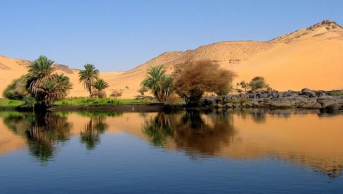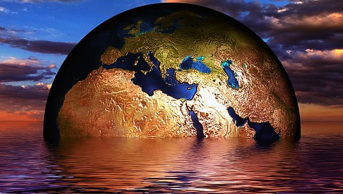Time for a New Water Paradigm in the Middle East: Why do we need the “Blue Revolution 2.0”?

Starting from early years of the twentieth century, many countries of the Middle East have experienced a process of water infrastructure construction which I would call the “blue revolution”.
It is a well-known fact that the Middle East is one of the regions that has very scarce water resources. Middle Eastern states were compelled to construct huge water infrastructure. These superstructures were complemented by irrigation networks, electrical grids, urban water networks, etc.
This first wave of the blue revolution yielded significant contributions to growing needs of populations of the region throughout the last century. Apart from sustained provision of vitally needed potable water, several Middle East countries were also able to grow all of their food for most part of the last one hundred years. To illustrate, state of Israel owes much to its National Water Carrier which was completed in 1964. Even today, after desalination became the number one source of fresh-water, it continues to comprise one of the major backbones of the whole water network in Israel. Besides, water became so important in terms of energy production, since countries like Egypt and Turkey -with little oil to use for energy generation- relied largely on water resources. For instance, when the Aswan Dam in Egypt started to generate electricity in 1967, it was able to produce half of the electricity that was being produced in the whole country. It was the Aswan Dam and the hidden power in the Lake Nasser’s peaceful but volumetrically immense waters that introduced electricity to Egyptian villages for the first time. After several millennia since the time of Pharaohs, a Dam was creating the biggest advancement for the rural communities in a country dominated by deserts accounting for more than 90 percent of the whole territory. Similarly, in Turkey, one of the biggest dams on Euphrates, with some 30 billion cubic meters of waters behind, the Keban hydropower dam was able to produce approximately 25 percent of the whole electricity produced in Turkey in 1974, when the dam was completed with four turbines out of eight.
In addition to these material impacts, relatively successful augmentation and management of water resources contributed to consolidation of statehoods in the Middle East, which could have otherwise been overridden by surmounting challenges of water, along with other pressing issues. History shows that if managed badly, predominantly agrarian economies with very rapidly increasing populations can become time bombs. Newly independent states of the Middle East averted these scenarios via utilization of water’s “buoyant force”.
But the fruitfulness of the first wave of blue revolution is diminishing. Construction of more dams, bigger hydropower plants, more expansive irrigation networks, and maintaining availability of tap water cannot move Middle East to a new level of development in face of the 21st century challenges, some of which are totally new and perhaps more intricate that necessitate not only innovative but also compound solutions.
First of all, there is very little water remains to be tamed. Consider Egyptians concerns over the Grand Ethiopian Renaissance Dam. Egypt, therefore, already reached -and even exceeded- its limits concerning the utilization of the River Nile. Continuation of sticking to older paradigm of water use may create more frictions across countries. Second, countries populations are continuing to increase, so are per capita consumption levels. In other words, people, today, are eating much more food than the past on average. Therefore, while reaching “food sovereignty” is rapidly becoming an unattainable goal, particularly for most of the Middle East countries where water shortages render agricultural activities very challenging for centuries; concomitant need for new water works may also become obsolete. Furthermore, yesterday’s benefits which are associated with the first blue revolution can become mere burdens in this new era. For instance, dams in shallow formations are more prone to evaporation losses which can be seen as very counterproductive, especially when one thinks of the heightened vulnerability of limited water resources in the context of climate change related impacts. This illustrates the wickedness of the water challenge that the Middle East is now required to deal with.
Under these circumstances, it is essential for the Middle East to change course regarding the way it approaches to water. I would call this new paradigm as the “Blue Revolution 2.0”. The main axis of the new era should be marked by a genuine and total agreement on the indispensability of increasing water efficiency as the overarching goal. Instead of supply-side measures, demand management policies and techniques should be enhanced, no matter how small these practices might create in terms of water savings. Examples of action within this new paradigm will also include a more devoted fight with erosion and evapotranspiration through specialized practices such as mulching, terracing, and adopting counter-drought measures like planting fruit trees (which are more resistant to drought) rather than subsistence crops.
For a region which once was the home of several earliest civilizations in the globe, construction of heavy water works can no longer be a cause for celebration. Today, the region faces some of the most daunting climate change scenarios and other water-related challenges which compel a paradigm shift.









